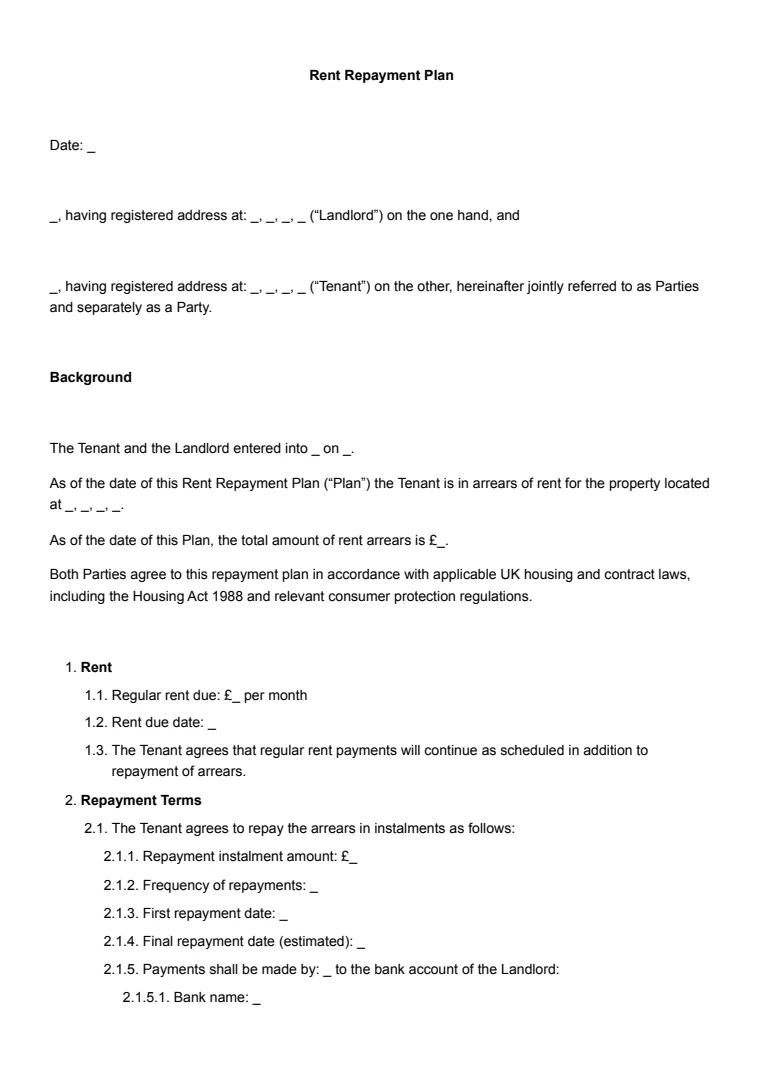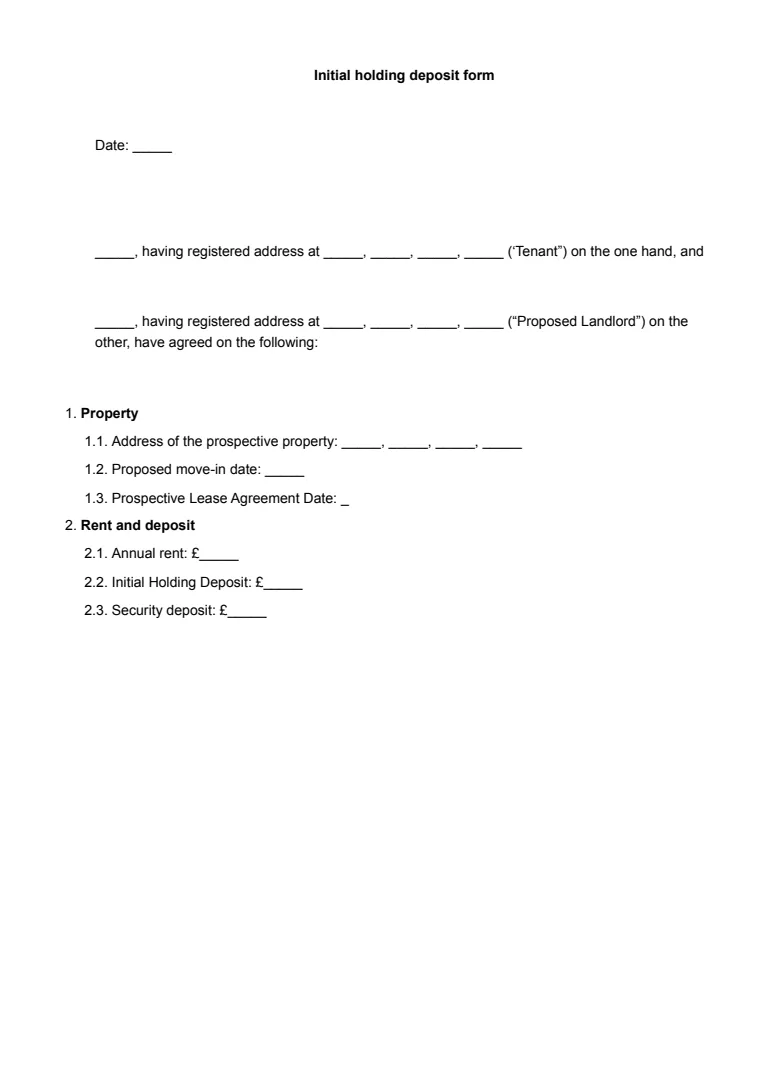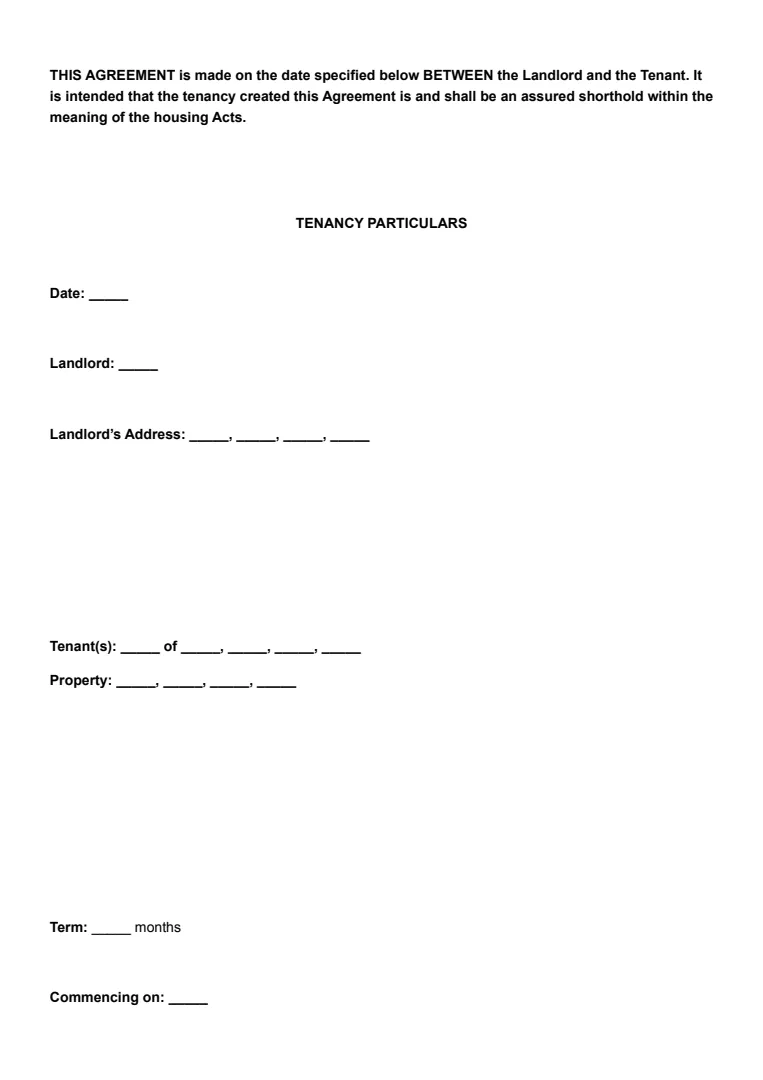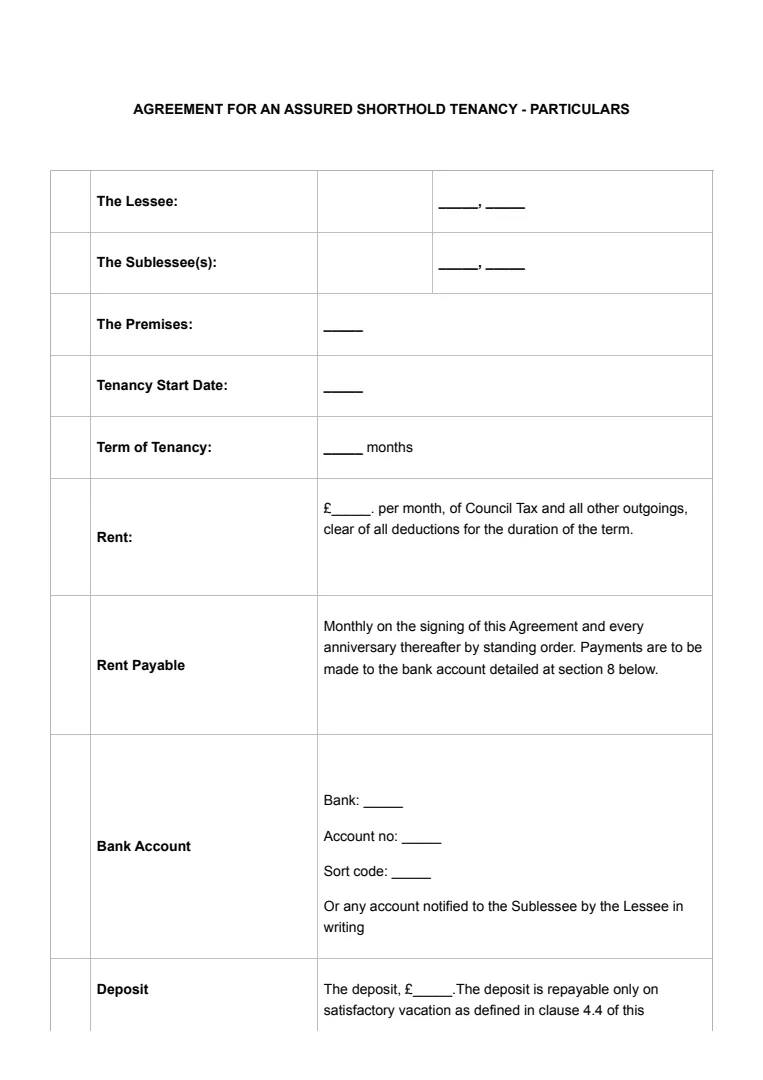What Is a Break Notice?
A break notice is a written communication served by one party to another to formally trigger a contractual right to end a lease early. It is most commonly associated with commercial leases that include a break clause, allowing termination on a specified date if certain conditions are met.
A commercial lease termination letter in the UK must be clear, specific, and delivered in strict compliance with the lease provisions. This typically involves stating the full names of the parties, the address of the property, the date of the lease, the relevant break clause, and the intended break date.
UK business tenancy law, particularly the Landlord and Tenant Act 1954 (legislation.gov.uk), sets the overarching framework, but the lease terms themselves dictate the exact requirements.
Failure to meet even one contractual condition, such as delivering the notice late or failing to meet pre-termination obligations, can nullify the break.
Expert Tip:
“If your lease is contracted out of the security of tenure provisions in the Landlord and Tenant Act 1954, a break clause may be your only route to ending the lease early. This makes accurate service of the notice critical, as you may have no other legal escape without breaching the contract.”
When Should You Use a Break Notice?
A break notice is most valuable when there is a legitimate need to end a commercial lease early while staying within contractual terms and avoiding disputes. Its strategic use can protect financial stability, give a business operational flexibility, or allow a landlord to act on opportunities that an existing lease would otherwise block.
Before exercising a break clause, the party serving the notice should weigh the potential cost savings against the requirements for compliance and the possibility of legal challenge.
You should use a break notice in the following instances or circumstances:
1. Adapting to Market Changes
Economic conditions can shift rapidly, affecting the profitability of leased premises. For example, a retailer might see a significant drop in high-street footfall due to changing consumer habits, local infrastructure works, or increased online competition.
Similarly, office tenants may find that hybrid working arrangements reduce their need for floor space. In these cases, a break notice allows the tenant to limit future liabilities and redirect resources towards channels with better returns.
However, timing is key—serving too early might mean giving up a potentially profitable location, while leaving it too late could result in missing the contractual notice window. Market research, sales data, and occupancy cost analysis should all inform the decision.
2. Relocation or Expansion Projects
Growing businesses often require a change in premises to accommodate new staff, production capacity, or specialist facilities. For instance, a technology company might outgrow its current office as it hires more engineers, or a manufacturing firm may need to move to an industrial site with higher power capacity and better logistics access. On the other end of the spectrum, companies consolidating operations after a merger may want to exit surplus leases to cut costs.
Using a break notice in these situations reduces the risk of paying rent on two properties at once. When relocating, it’s essential to plan the overlap between old and new sites to avoid operational disruption, especially in industries where continuous operations are critical.
3. Landlord Redevelopment or Value Release
Landlords may exercise a break clause as part of a wider investment or redevelopment strategy. Ending a lease early can enable them to renovate a property, convert it to a different use, or secure a tenant willing to pay a higher rent. For example, a landlord might wish to convert an underutilised office building into residential flats in line with local planning trends.
In other cases, a break might be used to gain control of adjoining units for a large redevelopment project. This approach must be balanced against the risk of void periods, potential loss of reliable rental income, and the possibility of the tenant disputing the validity of the notice. The UK Government’s Ending a Business Tenancy guide (gov.uk) provides further insight into lawful routes for landlords to regain possession.
Expert Tip:
“If you are a landlord serving a break notice for redevelopment purposes, check planning permissions and financing before terminating the lease. Prematurely ending a tenancy without a clear redevelopment plan can lead to income loss and extended void periods.”
How to Write a Break Notice
Drafting a break notice is not just about putting words on paper; it’s a process that requires strict compliance with the lease terms and, in some cases, relevant statutory requirements. Even experienced landlords and tenants can make costly mistakes by overlooking small but critical details.
Before you even begin writing, take the time to conduct a clause-by-clause review of the lease. Identify the notice period, the exact wording of the break clause, and any conditions that must be satisfied. These may include paying all rent and service charges up to the break date, repairing or reinstating alterations, or giving vacant possession.
Creating a checklist from the lease provisions can help ensure nothing is missed and can serve as an internal audit tool before service.
Here’s a step-by-step guide to creating a clear break notice.
Step 1: Review the Lease and the Break Clause Requirements
This step is about more than just confirming the number of months’ notice needed. You must also check for specific procedural requirements that could void the notice if overlooked.
For example, some leases demand that the break date fall on a quarter day or require that the notice be served on multiple parties, such as both the landlord and their managing agent.
If the lease specifies “full compliance with tenant covenants” as a condition, even minor breaches like an unapproved alteration or a late rent payment months earlier can be used to challenge the break. This is why legal practitioners often recommend a pre-break compliance review to identify and fix any issues before the notice is sent.
Expert Tip:
“Always diarise the latest possible date you can serve the notice and work backwards, building in a buffer for postal or courier delays. A single day’s delay can invalidate the break entirely.”
Step 2: Draft Clear, Unambiguous Wording
The language in a break notice must be precise and unequivocal. Courts interpret these documents literally, and any ambiguity can be fatal to their validity. Include the full legal names of both parties, the property’s complete postal address, the date of the lease, and the exact clause being exercised.
The break date should be stated in a clear calendar format, such as “31 December 2025,” rather than relative terms like “the end of the year.” Avoid vague language or conditional phrases, such as “we may” or “we intend to”, as these can be interpreted as uncertain and therefore ineffective. In high-value leases, some parties engage specialist solicitors or use a vetted break clause letter template to ensure the wording aligns perfectly with the contractual terms.
If you want to skip manual drafting, Legally.io’s document generator can create a compliant break notice in minutes, tailored to UK law and your industry.
Step 3: Serve the Notice Exactly As the Lease Dictates
Service is one of the most common points of failure in break notices. Even if the document is perfectly drafted, serving it incorrectly can render it void.
The lease will set out the permitted service methods, which might include personal delivery, recorded post, or courier to a specific address. If the lease requires service to a registered office, do not substitute this with an operational address unless explicitly allowed.
Always build in extra time to account for postal delays or delivery issues, and keep comprehensive proof of service. This could include postal tracking receipts, signed delivery acknowledgements, or sworn witness statements if delivered by hand.
The UK Government’s giving notice guide (gov.uk) sets out general best practice, but remember that your lease may impose stricter, contract-specific requirements.
Step 4: Maintain Compliance Until the Break Date
Serving the notice is only part of the process; conditions often extend to the break date itself. This means paying all rent, service charges, and any other sums due up to and including the final day of the lease.
If the clause requires vacant possession, ensure that all personal property, equipment, and alterations are removed before handing back the keys. A landlord may refuse to accept the break if even minor items remain on site.
Document every step: photograph cleared spaces, record meter readings, and obtain written acknowledgement of key return. In cases where reinstatement is required, complete this work well in advance to allow for inspection and any remedial action.
Expert Tip:
“If vacant possession is a condition, treat it as a project in itself—schedule removal of goods, book contractors early, and allocate time for final inspections to avoid last-minute disputes.”
What Should a Break Notice Contain?
A robust break notice must contain certain key details to ensure it is legally valid and cannot be challenged for lack of clarity. Each of these elements plays a role in identifying the parties, defining the lease being terminated, and confirming compliance with the lease terms.
Missing or incorrect information in any one of these areas could jeopardise the validity of the notice.
Legal Full Names
The break notice should state the full legal names of both the landlord and tenant exactly as they appear in the lease agreement. For individuals, this means their full given name(s) and surname; for companies, it must match the name registered with Companies House. If the lease has been assigned, ensure the current tenant’s name is used, not the original tenant’s; otherwise, the notice may be considered invalid. Checking against official records helps avoid spelling errors or outdated information.
Addresses
Include the correct addresses for both parties as stated in the lease or as updated by formal notice during the lease term. For the landlord, this may be a registered office address or another designated address for service. For the tenant, it is typically the leased property’s address, but if the lease specifies an alternative service address, use that instead. Including the full postal address of the property itself ensures there is no ambiguity about which premises the notice relates to.
Company Registration Numbers
Where either party is a registered company, the notice should include its company registration number exactly as recorded at Companies House. This is especially important when companies have similar names or have undergone rebranding during the lease term. The registration number provides a unique identifier, removing any doubt about the legal entity being referenced.
Property Description
Clearly identify the property being leased, including its full postal address, postcode, and any title number if known. If the lease covers more than one unit, floor, or part of a building, specify the exact demised premises to avoid disputes. In multi-let properties, referencing a plan or schedule from the lease can be useful to confirm the area being vacated.
Lease Date and Clause Reference
State the date of the lease in full and cite the specific clause number that contains the break right. This connects the notice directly to the legal document and makes it easy to verify that the clause is being exercised correctly. Some leases also have supplemental or variation agreements. If relevant, note these as well to avoid confusion.
Break Date and Notice Period Confirmation
The notice must include the exact break date, stated in a calendar format such as “31 December 2025,” not relative terms like “the end of the year.” You should also confirm that the notice is being served per the notice period required in the lease, for example, “This notice is served not less than six months prior to the break date.” This eliminates doubt about whether the timing requirement has been met.
Pre-Condition Acknowledgement
If the lease includes pre-conditions, such as delivering vacant possession, paying all rent and service charges, or complying with all covenants, state explicitly that these obligations will be met. This not only signals intent to comply but also reduces the risk of the landlord challenging the break on procedural grounds.
Method of Service
While not always mandatory, including a statement about how the notice is being served provides a clear record of compliance. For example: “This notice is served by Royal Mail Special Delivery to the address specified for service in clause X of the lease.”
Retaining proof of service is essential, and noting the method in the notice can strengthen the evidential record.
Signature and Authority
The notice must be signed by an authorised person. For companies, this could be a director or company secretary in line with the Companies Act 2006 (legislation.gov.uk), or two authorised signatories. For individuals, the tenant must sign personally. If an agent signs on behalf of either party, they should have clear written authority to do so, and it should be stated in the notice.
Legally.io’s commercial lease termination notice template for the UK already includes all these details, saving you hours of drafting and reducing the risk of missing critical protections.
Legal Tips for Writing a Break Notice
- Serve well before the deadline – Timing errors are a leading cause of invalid break notices. Calculate the notice period by counting backwards from the break date stated in the lease, and build in a buffer for postal or courier delays. Serving too close to the cut-off date leaves no room to correct errors if the notice is challenged or returned undelivered.
- Check covenant compliance in advance – Many break clauses require full compliance with tenant obligations up to the break date. Even minor breaches, such as unpaid service charges or small maintenance issues, can give the landlord grounds to reject the break. A pre-break compliance audit can identify issues early so they can be remedied before the notice is served.
- Meet vacant possession requirements – If the lease requires vacant possession, ensure all personal property, equipment, rubbish, and alterations are removed before the break date. The NYK Logistics (UK) Ltd v Ibrend Estates BV (bailii.org) case confirms that leaving even security staff or minimal items behind can invalidate the break.
- Document every step – Keep dated photographs of cleared premises, meter readings, and written confirmation of key returns. This creates evidence in case the landlord disputes whether vacant possession or covenant compliance was achieved.
- Follow service provisions exactly – Ensure the notice is sent by the method and to the address specified in the lease. If multiple landlords are listed, serve each one separately. Keep proof of service, such as signed delivery receipts or postal tracking records, in case validity is challenged.
Key Takeaways
A break notice is a precise legal instrument, and even small mistakes can make it ineffective.
To get it right, review the lease carefully, draft with clarity, follow all procedural requirements, and maintain compliance with lease obligations up to the break date.
Used strategically, it provides flexibility for both landlords and tenants, allowing them to adapt to changing needs while staying within the law.
The key is attention to detail and early action to avoid last-minute errors.














